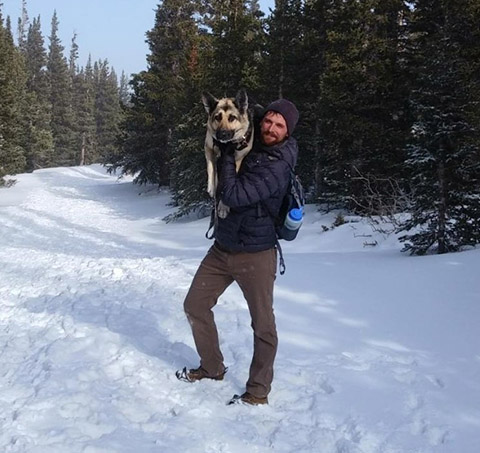Q&A With Jordan Cox: Expect the Unexpected With Resilient Systems
A resilient system can withstand disruptions, mitigate potential losses, and recover rapidly. Planning for an unexpected event is a significant challenge, but one that the National Renewable Energy Laboratory's (NREL's) researchers in the Resilient Systems Design and Engineering Group within the Energy Security and Resilience Center are working to address.

In this interview, resilience researcher Jordan Cox described NREL's innovative approach to analyzing system vulnerabilities, measuring risk, and keeping communities safe.
How did you become interested in renewable energy, and what led you to NREL?
I am an odd duck at NREL. In college, I became very interested in energy poverty, energy access, and energy security. I wanted to address these issues, so I pursued a Ph.D. in nuclear engineering as a promising solution to meet future needs. However, as I evaluated the economics of energy sources, I became more interested in the availability of renewable energy and how it can be deployed in really remote communities. That is what led me to move from a nontraditional nuclear background to my renewable energy focus at NREL.
Energy access is a never-ending process, even with renewable energy added to the mix. Although we are deploying gigawatts of energy capacity in developing countries, if we continue at our current pace, it's possible that by 2050 more people will be without energy than there are today due to population growth.
How does a resilience assessment work?
Resilience assessments are an important part of our Resilient Systems Design and Engineering Group's research activities. First, using a combination of qualitative and quantitative methods, we assess hazards, threats, and vulnerabilities to establish a risk score for the entire site. The risk score is created for different assets and for different types of disruptive events—from naturally occurring to man-made. Next, we help the stakeholders draft mitigation solutions to improve their site's resilience posture over time, and work to analyze how investments can reduce overall risk scores. One of the first things we look at is adding energy assets to ensure backup power is available or there is power supply on site, but we also examine things like water, transportation, and communication systems, to create a holistic set of solutions.
What is a current project you are excited about?
In a recent project, we have partnered with the client's internal climate analysis teams to help understand the resilience of certain facilities. With access to their robust climatological data sets, we were able to refine our analysis to detect resilience vulnerabilities at the sites that we wouldn't have seen without the data. We also have a few projects related to the economics of resilience that will really push the envelope on the cost-benefit calculations of resilience. This research can help decision-makers invest in mitigation solutions now to prevent impacts in the future.
What metrics are used to value resilience?
Resilience metrics are an area of active research and often falls into system performance or attributes-based metrics. It's possible to take reliability metrics and translate them into extreme scenarios to produce resilience metrics. More resilience-specific metrics include recovery costs, expected annual loss, and outage magnitudes, defined by the number of customers and days without power. We are also expanding on social burden and community impacts more broadly, so watch this space.
Can you give an example of resilience metrics?
The Department of Energy Building Technologies Office funded research to estimate the value of resilience for energy efficiency. We developed scenarios of extreme heat and cold waves that were fed into various building models at NREL, Pacific Northwest National Laboratory, and Lawrence Berkeley National Laboratory to estimate if a modeled building would retain a livable temperature for its occupants if it lost power. The modeling revealed how energy efficient building design has the potential to enhance survivability during extreme temperature conditions when power is lost for different lengths of time.
What tools do we have to visualize future scenarios and help us prepare for what's next?
I don't have all the answers for this, as it's a big question. We are working on probabilistic risk assessments, Monte Carlo analyses, and REopt-level simulations to narrow the gap in this research. I also transform climate change projections into power system model inputs. We are building a library of historic and synthetic events that can be used in simulation tools like REopt™. With synthetic events in particular, one can take large historical data sets of extreme weather events and apply machine learning to recreate them and then adjust the data to be more representative of climate change related events. This research will, hopefully, help us to understand future conditions and inform our system designs to reduce impacts to future events.
What are the challenges or opportunities of working in such a cross-cutting specialty?
The researchers within the Energy Security and Resilience Center work across technologies at the lab. I often view us as an internal resource that anyone can reach out to when they want to apply resilience related analyses to their projects. We have resources that we can provide, such as the latest or most relevant literature and data sets, and we can recommend resilience methodologies or mitigation solutions that projects could potentially adopt. Depending on the situation, we may be able to share resources, or a resilience expert can be added to the project. Either way, we get to hear about a lot of different research going on in the lab and think innovatively about how resilience analysis could benefit those projects, which I really enjoy.
What do you do for fun outside of work?
Like most Coloradans, I love hiking, trail running, paragliding, and rock climbing. I also do a lot of cooking, especially in the winter when the outdoors is a little less accessible.
Last Updated May 28, 2025
